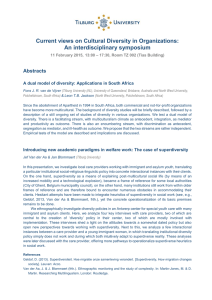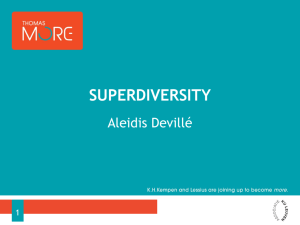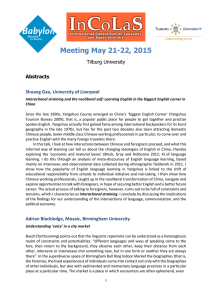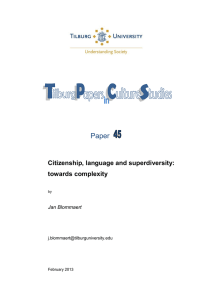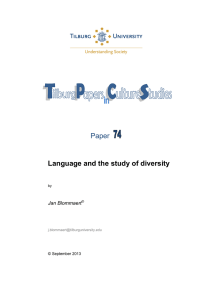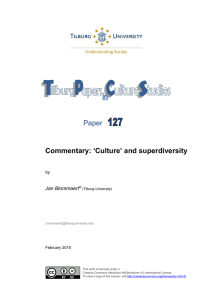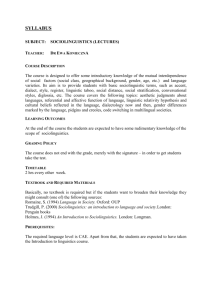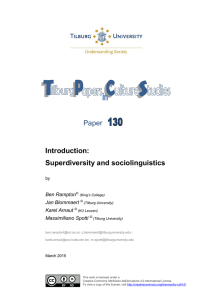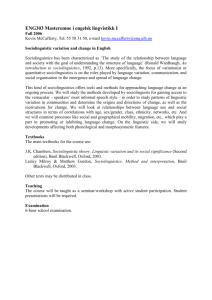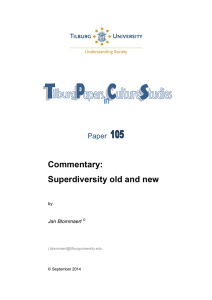Paper The second life of old issues: How superdiversity ‘renews’ things
advertisement
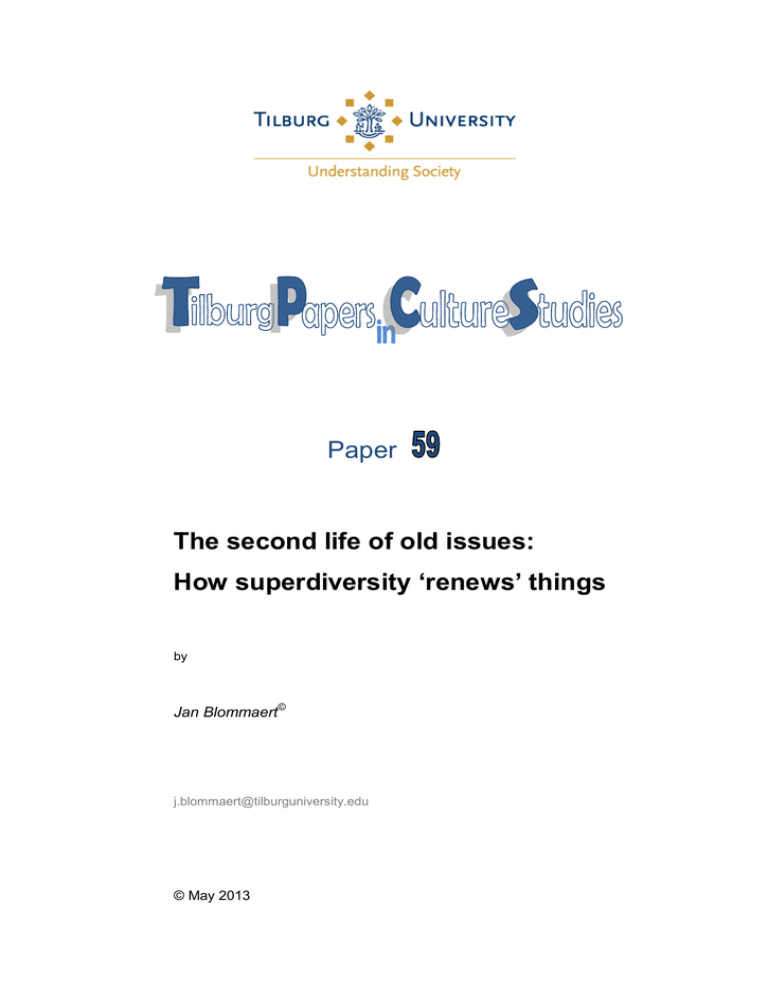
Paper The second life of old issues: How superdiversity ‘renews’ things by Jan Blommaert© j.blommaert@tilburguniversity.edu © May 2013 The second life of old issues: How superdiversity ‘renews’ things Jan Blommaert [Contribution to the UK Linguistic Ethnography Forum e-seminar discussing Rob E. Moore, “‘Taking up Speech’ in an endangered language: Bilingual discourse in a heritage language classroom”, Working Papers in Educational Linguistics 27: 57-78, 2012.] Introduction Rob Moore’s brilliant paper deserves comments on more than one aspect, because it is relevant to a range of domains and subdomains of sociolinguistics and applied linguistics. The aspect of ‘pooling’ of linguistic (and literacy) resources is something that pervades every language teaching and learning environment, and studies of teaching and learning would benefit from approaching events in terms of unequally distributed resources that, gradually and incompletely, can be redistributed in the process of teaching and learning. This is one example. A second example of how Moore’s paper could reinvigorate research is in the field of minority languages and language endangerment. Moore powerfully makes the point that many small languages continue to exist in the way he describes: as parts-here-and-parts-there, divided over a population rather than concentrated in an individual, and deployed and displayed in specific (often ritualized) contexts. Seen from this pragmatic and metapragmatic angle, many languages will show great resilience (perhaps this is reassuring to their most ardent language activists), while attention is drawn to language as a sociolinguistic system – more precisely an endangered language in a skeleton sociolinguistic system characterizing the early stages of language revival, as well as more permanent phases of language survival. The key point made by Moore, however, revolves around the notion of the unified, fully fluent L1 speaker. More precisely, Moore’s case shows how in the language endangerment context of the Warm Springs reservation, we can see phenomena more widely observed in what has gradually grown into a 1 sociolinguistics of globalization and superdiversity. Studies such as Rampton’s Crossing (1995) dislodged this traditional view of the ideal speaker-hearer a long time ago; several other studies (Moore reviews them) had already hinted at such phenomena and/or would follow Rampton’s lead in reformulating the ‘native speaker by degrees’. The thing is that these dislodging patterns were not found in what many would call ‘traditional’ societies (Warms Springs and its ‘tribes’ would be seen as such by many; but note Moore’s historical and contemporary qualifications); they were situated in late-modern post-industrial urban centers, and often connected to complex online-offline popular cultural developments. And scholars of the former would rarely mix with scholars of the latter – both ‘worlds’, so to speak, belonged to different scholarly galaxies and Never the Twain Shall Meet. Cutting a few corners, we can see how insights firmly lodged within contemporary developments in the study of language and superdiversity appear, and appear as firmly entrenched, in communities that would not intuitively be labeled superdiverse. A ‘tribal’ area, in widespread imagination, is a homogeneous, let us say ‘subdiverse’ area (one has to ‘belong to’ that tribe in order to reside there), while superdiverse spaces are characterized by intense and intrinsic variation. So: what is this superdiversity all about, when ‘superdiverse’ features can be found in ‘subdiverse’ communities? New, old or both? This question can be heard in various corners: what is new about superdiversity? Haven’t we seen all of this before? And do we need superdiversity when so much it brings to the surface is a matter of recognition of patterns and processes already long present? Let me try to answer this question. In Blommaert & Rampton (2011), we described language and superdiversity as a space of synthesis, a point of convergence or a nexus of developments long underway. Moore provides an excellent survey of some of them. We presented superdiversity as a paradigm, 2 not a subdiscipline – it is defined primarily by a theoretical and methodological perspective rather than by a set of specifically ‘superdiverse’ phenomena. I will return to these phenomena in a moment. This perspective revolves around the acceptance of uncertainty in sociolinguistic analysis: the fact that superdiversity denies us the comfort of a set of easily applicable assumptions about our object, its features and its meanings. From this acceptance of uncertainty, two other methodological principles follow: (a) we see complexity, hybridity, ‘impurity’ and other features of ‘abnormal’ sociolinguistic objects as ‘normal’; and (b) the uncertainty compels us towards an ethnographic stance, in which we go out to find out how sociolinguistic systems operate rather than to project a priori characteristics onto them. With regard to (a) above, what superdiversity has provoked, I believe, is an awareness that a lot of what used to be qualified as ‘exceptional’, ‘aberrant’, ‘deviant’ or ‘unusual’ in language and its use by people, is in actual fact quite normal. The exception has become the rule, so to speak. Historically, there is some logic behind this insight. Many of the scholars currently working on language and superdiversity were working on codeswitching a couple of decades ago. Codeswitching was, until the mid-nineties, widely seen as a ‘deviant’ phenomenon, violating a default rule of monolingual speech, seriously complicating linguistic analysis, and often situated only among bilingual communities (also presented as something rather unusual). People may wish to return to landmark work such as that of Carol Myers Scotton (1993) for evidence of the abnormalization of codeswitching. They will encounter a world of strange bilingual creatures doing strange things with two languages, causing complications in social life and sending two grammars battling in their minds (cf. Meeuwis & Blommaert 1994). Working on forms of codeswitching and on the particular patterns of multilingualism they suggested meant that scholars came across increasingly ‘messy’ data – effects, indeed, of the gradual increase of diversity in large urban centers around the world, as well as, somewhat later, the strange new forms of 3 literacy crawling through the internet. Peter Auer’s (1998) collection Codeswitching in Conversation testifies to the engagement of researchers with increasingly complex forms of mixing and shifting, and to the fundamental questions that emerged from them. (The list of contributors includes at least five scholars currently explicitly working on language and superdiversity: Jens Normann Jorgensen, Ben Rampton, Christopher Stroud, Li Wei and Jan Blommaert.) The thing is that, engaging with such messy materials, questions of ‘language’, ‘community’, ‘meaning’ came up – questions evidently having far wider relevance than just in this field of messy stuff. To be sure, such question did not only emerge from such work. US-based linguistic anthropology had equally questioned the fundamentals of the study of language, and especially since the emergence of the language ideology trend in the early nineties important critical work emerged in quantities (e.g. Hymes 1996; Silverstein 1998; Gal & Woolard 2001; Bauman & Briggs 2003; Agha 2007). The influence of this work on the emergence of language and superdiversity as a space for synthetic work is a matter of record (see for instance Blommaert & Rampton 2011). The fact that this new linguistic anthropology generated possibilities for a new and more analytically powerful linguistic ethnography was effectively a factor of tremendous importance (see e.g. Rampton 2007). The point, however, is that a space of theoretical work emerged in which ‘exceptional’ forms of language were increasingly seen as privileged lenses through which a different gaze on all of language became possible. In other words: starting from exceptionally ‘unusual’ language, ‘normal’ language also began to look different. And as soon as questions emerging from superdiverse contexts were projected onto contexts not often associated with it, the empirical scope of language and superdiversity dramatically broadened, and the field became paradigmatic, a different perspective by means of which all facts of language could be redefined and re-analyzed. Moore’s paper is an instantiation of it. 4 To be sure, I firmly believe that language and superdiversity has a range of specific objects – think of online communication and its hugely complex semiotic forms. Obviously, such objects are new: the internet did not exist when Gumperz and Hymes compiled their Directions in Sociolinguistics (1972). Specific forms of urban multilingualism, now also shot through with traces of a globalized pop culture, are also new and could be called specific ‘superdiverse’ sociolinguistic objects. I also firmly believe that the change of knowledge infrastructure – the internet and contemporary popular culture – is often underestimated as a factor of fundamental change (cf. Burke 2000), and that, consequently, we should not too quickly dismiss new e-phenomena as merely a re-enactment of phenomena already known and understood. A change in knowledge infrastructure is a change in the entire economy of knowledge, and even if things look the same linguistically, they can have a very different sociolinguistic role, distribution and function. But I also do believe that the range of specific objects is small and in itself perhaps not all that extraordinary: we encounter objects that are more complex by degree, not qua substance, compared to forms of intense mixedness and hybridization recorded in earlier times. What is truly new, therefore, is the perspective and not the objects. It is the perspective that enables us not just to analyze the messy contemporary stuff, but also to re-analyze and re-interpret more conventional and older data, now questioning the fundamental assumptions previously used in analysis. It’s a new theoretical approach to language, period. And since it is an approach that starts from what earlier was seen as ‘exceptional’, it will explain exceptions better than the theory that produced these exceptions. The fact, therefore, that there is only a small set of phenomena that can be called specifically ‘superdiverse’, does not reduce the usefulness of the theoretical intervention: recall that Quantum theory did not replace Newtonian physics, it just explained its exceptions, but in so doing it recast the foundations for the understanding of vastly more. It also did not need a new universe for that: the universe was exactly the same for Isaac Newton and Niels Bohr; the understanding of the universe changed, not its existence. There is of course no reason to extend this analogy or take it too literally; but the comparison can show us the usefulness of new perspectives on 5 old issues, how such perspectives can ‘renew’ the old issues, explain some of their previously inexplicable aspects, and so bring a very broad range of issues within their purview. Back to Kiksht What makes Rob Moore’s paper so exceptionally clear and persuasive is its historical framing. We can see how Moore applies a new theoretical instrument to the events he discusses and establishes the core point of his paper: the fact that the Kiksht speakers do not appear burdened by unified notions of the ‘native speaker’. Indeed, if we would take any one of the subjects Moore describes in his analysis, none of them would be the ideal ‘informant’ in a classic descriptivelinguistic set-up. While Mrs Thompson and Mrs McIndruff ‘possess’ perhaps most forms in the language, observe the complexities of ‘speaking’ here. From this ‘renewed’ analysis, in which he applied a new instrument to data gathered years ago, Moore also re-reads statements from classic anthropology – Sapir, Boas, Bloomfield and others also noted the degrees of fluency and the complexities of performing the language. And we can now perceive the methodological problems experienced by these older anthropologists as illustrations of what has in the meantime become understandable: the ‘normal’ pattern of unevenly distributed linguistic resources in a community, and the intense ritualizations of performance that revolve around such uneven patterns of distribution. We now have a mature sociolinguistic vocabulary for things previously disqualified and excluded from analysis, and commented on in disparaging terms as ‘speaking poorly’ or ‘insufferably’, as ‘gibberish’, ‘sabir’ or ‘patois’ but never as ‘language’. Needless to say that such quick and damning judgments persist and are widespread today in a broad range of fields, from language education to immigration and the labor market. We thus have an opportunity here to relax our attitudes towards language and superdiversity as a new development in sociolinguistics. It is not a threat to anyone, it will not snatch away anyone’s data or terrain of expertise. It can be 6 useful to everyone, provided we see it as an intellectual opportunity we ought to be familiar with: the periodic desire to unthink and rethink the things we feel reasonably at ease with – the meaning of the ‘re’ in research. Rob Moore provides us with an excellent example of how to proceed with this, and how we can make this new instrument useful for a wide range of difficult old and new questions. References Agha, Asif (2007) Language and Social Relations. Cambridge: Cambridge University Press Auer, Peter (ed.) (1998) Code-switching in Conversation. London; Routledge Bauman, Richard & Charles Briggs (2003) Voices of Modernity. Cambridge: Cambridge University Press. Blommaert, Jan & Ben Rampton (2011) Language and Superdiversity. Diversities 13/2: 1-22. Burke, Peter (2000) A Social History of Knowledge: From Gutenberg to Diderot. Cambridge: Polity. Gal, Susan & Kathryn Woolard (eds.) (2001) Languages and Publics: The making of Authority. Manchester: StJerome Gumperz, John & Dell Hymes (eds.) (1972[1986]) Directions in Sociolinguistics: The Ethnography of Communication. London: Blackwell Hymes, Dell (1996) Ethnography, Linguistics, narrative Inequality: Toward an Understanding of Voice. London: Taylor & Francis Meeuwis, Michael & Jan Blommaert (1994) The markedness Model and the absence of society: Remarks on codeswitching. Multilingua 14/4: 387-423. Myers-Scotton, Carol (1993) Social Motivations for Codeswitching: Evidence from Africa. Oxford: Oxford University Press Rampton, Ben (1995) Crossing: Language and Ethnicity among Adolescents. London: Longman Rampton, Ben (2007) Neo-Hymesian linguistic ethnography in the UK. Journal of Sociolinguistics 11: 584-608. Silverstein, Michael (1998) Contemporary transformations of local linguistic communities. Annual Review of Anthropology 27: 401-426 7 8
